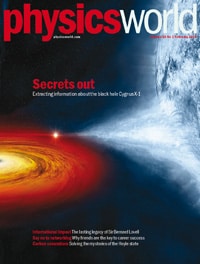By Matin Durrani
It’s the first of the month so – as if by clockwork – the February issue of Physics World is now ready for your enjoyment, in print, online and through our apps.

Our lead news story this month is about how Barack Obama, who was sworn in for a second term as US president last month, deals with the US “fiscal cliff” and what impact any resolution has on funding for science.
Elsewhere, we examine the lasting impact of two famous astronomers – Fred Hoyle and Sir Bernard Lovell. The former’s impact is felt most acutely in the “Hoyle state” – a short-lived excited form of carbon-12 that holds the clue to life in the universe but is still baffling today’s best nuclear physicists. As for Lovell, his notorious visits to the Soviet Union in the 1960s at the height of the Cold War might have been frowned upon by authorities in the West, but they set the tone for international collaboration and helped to pave the way to today’s ITER fusion experiment.
There’s also a great feature on how researchers are gaining valuable information about the black hole Cygnus X-1. Plus don’t miss Peter Kenny’s lateral thoughts about the mysteries of mathematical subtraction and find out why friends hold the key to career success.
If you’re a member of the Institute of Physics, you can access the entire new issue online through the digital version of the magazine by following this link or by downloading the Physics World app onto your iPhone or iPad or Android device, available from the App Store and Google Play, respectively.
If you’re not yet a member, you can join the Institute as an IOPimember for just £15, €20 or $25 a year via this link. Being an IOPimember gives you a full year’s access to Physics World both online and through the apps.
For the record, here’s a rundown of highlights of the issue:
• Fiscal cliff leaves funding concerns – Impending cuts to science may temper the optimism that some physicists had over the re-election of Barack Obama, as Peter Gwynne reports
• The rocky road to reform – A power struggle at one of Serbia’s largest and best known science institutes has led to its director being forced to resign after allegedly failing to restructure the lab, as Mićo Tatalović reports
• Thinking big about the future – As the US eyes a manned mission to an asteroid or Mars, Kirstin Matthews and Padraig Moloney argue that NASA needs better support for basic research – especially nanotechnology – to realize such ambitions
• Game-show physics – Robert P Crease explains why science is never an idealized process that operates following simple rules
• The secret of life – Life as we know it would not be possible were it not for a particular nuclear energy level of carbon-12 predicted 60 years ago by Fred Hoyle. But the true nature of this energy level remains one of the biggest unsolved questions in nuclear physics, say David Jenkins and Oliver Kirsebom
• A fusion of minds – Mystery still surrounds the visit of the astronomer Sir Bernard Lovell to the Soviet Union in 1963. But his collaboration – and that of other British scientists – eased geopolitical tensions at the height of the Cold War and paved the way for today’s global ITER fusion project, as Richard Corfield explains
• The swan’s dark heart – Astronomers discovered what they thought was the first black hole more than 40 years ago but have only recently verified its identity by establishing its distance, mass and spin. These fascinating observations are yielding new insights into Cygnus X-1’s past and future, as Ken Croswell explains
• Another side of black holes – Kulvinder Singh Chadha reviews Gravity’s Engines: the Other Side of Black Holes by Caleb Scharf
• Visible improvements – James Davenport reviews Visual Strategies: a Practical Guide for Scientists and Engineers by Felice Frenkel and Angela DePace
• Forget about networking – Marc Kuchner argues that if scientists really want to advance their careers, they should concentrate on making friends instead of networking
• Borrowing from nowhere – In this month’s Lateral Thoughts, Peter Kenny gets all mixed up with subtraction


